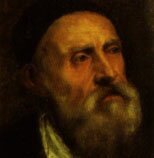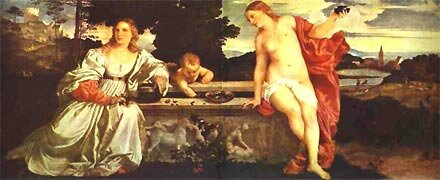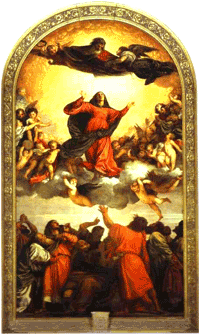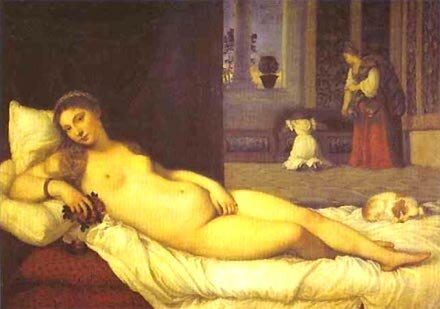

Îãëàâëåíèå ÐåôåðàòûVenetian RenaissanceTitian (circa 1476-1576)
The evidence for his birthdate is contradictory, but he was certainly very old when he died. He received the more important part of his training in the studio of Giovanni Bellini, then came under the spell of Giorgione, with whom he had a close relationship. In 1506-08 he assisted him with the external fresco decoration of the Fondaco dei Tedeschi, Venice, and after Giorgione's early death in 1510 it fell to Titian to complete a number of his unfinished paintings. The authorship of certain works (some of them famous) is still disputed between them. Titian's first great commission was for three frescos in Padua (Scuola del Santo, 1511), noble and dignified paintings suggesting an almost central Italian firmness and monumentality. When he returned to Venice, Giorgione having died and Sebastiano gone to Rome, the aged Bellini alone stood between him and supremacy, and that only until 1516 when Bellini died and Titian became official painter to the Republic. Meanwhile he was gradually free from the stylistic domination of Giorgione and developed a manner of his own. Something of a fusion between Titian worldliness and Giorgione's poetry is seen in the enigmatic allegory known as Sacred and Profane Love. This one of the famous and mystical Titian’s creature was painted in around 1515. As it was said before, it was the time in his art when the influence of Giorgone became less. But the common features of the both artists are still here. Two female figures are the miphological mystery of place and time. There is a play of contrasts. In the subject it is the contrast between the simple attire of one woman and the beautiful nudity of the other. In the composition the contrast is between the vertical figures and horizontal lines of landscape. In the paint scale the contrast is between the grey dull color of dressed women and the flayming-red drapery of nude women, between the brownish-green landscape and the reddish sky. (2, p. 60) This work inaugurated a brilliant period in Titian's creative career during which he produced splendid religious, mythological, and portrait paintings, original in conception and vivid with color and movement. A series of great altarpieces opens with the Assumption, which in the soaring movement of the Virgin, rising from the tempestuous group of Apostles towards the hovering figure of God the Father. The Virgin’s figure, clothed in red and captures in dramatic movement, forms the central focus of a painting that splendidly exemplifies religious grandeur.
According with George Holmes, that kind of painting contradicts the stable basis of quattrocento and High Renaissance composition and looks forward to the Baroque. (1, p. 230) The strong, simple colors used here, and the artist's evident pleasure in the silhouetting of dark forms against a light background, reappear throughout the work of this period. There followed the Pesaro altarpiece (Sta Maria dei Frari, Venice, 1519-26), a bold diagonal composition of great magnificence in which architectural motifs are used to enhance the drama of the scene, and the altarpiece of St Peter Martyr (now destroyed but known to us from several copies and engravings), where trees and figures together form a violent centrifugal composition suited to the action; Vasari described it as `the most celebrated, the greatest work... that Titian has ever done'. Titian's finest mythological works from this period are three pictures (1518-23) for Alfonso d'Este -- the Worship of Venus, the Bacchanal, and the Bacchus and Ariadne -- and outstanding among his portraits is the exquisite Man with a Glove. About 1530, the year in which his wife died, a change in Titian's manner becomes apparent. The vivacity of former years give way to a more restrained and meditative art. He now began to use related rather than contrasting colors in juxtaposition, yellows and pale shades rather than the strong blues and reds which shouldered each other through his previous work. In composition too he became less adventurous and used schemes which, compared with some of his earlier works, appear almost archaic. Thus his large Presentation of the Virgin makes use of the relief-like frieze composition dear to the quattrocento. During the 1530s Titian's fame spread throughout Europe. In 1530 he first met the emperor Charles V (in Bologna, where he was crowned in that year) and in 1533 he painted a famous portrait of him. Charles was so pleased with it that he appointed Titian court painter and elevated him to the rank of Count Palatine and Knight of the Golden Spur -- an unprecedented honor for a painter. At the same time his works were increasingly sought after by Italian princes, as with the celebrated Venus of Urbino, named after its owner, Guidobaldo, Duke of Camerino, who later became Duke of Urbino. Titian painted the Venus of Urbino in 1538. In this very beautiful painting one remembers the calmness that the blue sky seen through the window and the kneeling servant. But of course its most surprising feature was the direct staring face of the woman. During the ages this work of Titian has been compared with Sleeping Venus of Giorgone. They mentioned the pose, colour, composition and other parameters. But most art critics think that it’s not a copy, as it have been often in the history of art with the teacher and his pupil. There is a big difference between them. Venus of Giorgone is sleeping, while the Titian’s looks at the spectator. Her look seems sleepy, but fixed. Sleeping Venus looks like the Moon. As if she is up in the clouds: she is cold and inaccessible. She has to be accepted as allegory. Venus of Titian, on the contrary, is a very vivid and warm. The artist shows us the inside space of painting, as if inviting us to sit on the brink of the bed. No wonder that Titian’s Venus is traditionally compared with courtesan. (7, p. 398) It can be said that Titian substitutes a direct sensual appeal for Giorgione's idyllic remoteness. (1, p. 230) Early in the 1540s Titian came under the influence of central and north Italian Mannerism. In 1545-6 he made his first and only journey to Rome. There he was deeply impressed not only by modern works such as Michelangelo's Last Judgement, but also by the remains of antiquity. His own paintings during this visit aroused much interest, his Danaia being praised for its handling and color and (according to Vasari) criticized for its inexact drawing by Michelangelo. Titian also painted in Rome the famous portrait of Pope Paul III and his Nephews. The decade closed with further imperial commissions. In 1548 the emperor summoned Titian to Augsburg, where he painted both a formal equestrian portrait (Charles V at the Battle of Muhlberg) and a more intimate one showing him seated in an armchair. He travelled to Augsburg again in 1550 and this time painted portraits of Charles's son, the future Philip II of Spain, and the greatest patron of his later career. Titian's work for Philip included a series of seven erotic mythological subjects (c. 1550-62): Danaia and Venus and Adonis, Perseus and Andromeda, The Rape of Europa, Diana and Actaeon, Diana and Calisto and The Death of Actaeon. Titian referred to these pictures as poesie, and they are indeed highly poetic visions of distant worlds, quite different from the sensual realities of his earlier mythological paintings. During the last twenty years of his life Titian's personal works, as opposed to those which busy assistants produced under his supervision and with his intervention, showed an increasing looseness in the handling and a sensitive merging of colors which makes them more and more immaterial. Autumnal tones reflected the artist's meditative spirit. About the same time his interest in new pictorial conceptions waned. About 1550-55 he had painted a powerful Martyrdom of St Lawrence, which had affinities with Mannerism in the types and movements of the figures. In 1564-67 he repeated the picture, but now the light, which played a dramatic part in the first version, became the chief feature, creating and dissolving forms. His powers remained undimmed until the end, and his career closed with the awe-inspiring Pietà, intended for his own tomb and finished after his death by Palma Giovane. With the appearance of Titian painting first became not only a description, whether dull or excited but a living piece of life trying to impress our life making it develop according to the dramatic impressions of the author. In the painting “St Sebastian” the hero hit by arrows is not is not crushed, he is standing above the chaos of the world surrounding him as if in constant movement. The colour’s beginning to lose its brightness, the picture becomes vague and the surface of the painting looks as if it is vibrating. The painting was made by Titian not long before he died. The topic is tragic but Titian is not frightened by it. He wished to conquer the human suffering and worries which embraced his own soul by showing them to us in full. When you come close it seems to you that the whole painting is the chaos of strokes. The works by late Titian should be watched from a certain distance. The chaos disappeares then, we see a youngster been killed by arrows among darkness and a burning fire on the background. The artist is desperate. But the hugeness of his desperation serves us as consolation because we understand this as a protest against the inevitability of this final. Titian survived the crash of the Renaissance ideals. The art of the painter belongs to the late Renaissance. His last years coinside with the end of the golden age with the end of the Renaissance epoch. That epoch breathed youngness and hope but then the hope was gone, together with the youngness it was gone, with the whole generation part of which was Titian. But his belief in a Man didn’t end. The hero standing up to fight his enemies and meeting his death bravely retaines his greatness. And maybe it is a symbolic that St. Sebastian was not sold by Titian and stayed in his art studio which means that it was with him until his last hours. Titian's influence on later artists has been profound: he was supreme in every branch of painting and revolutionized the oil technique with his free and expressive brushwork. Vasari wrote of this aspect of his late works that they `are executed with bold, sweeping strokes, and in patches of color, with the result that they cannot be viewed from near by, but appear perfect at a distance... The method he used is judicious, beautiful, and astonishing, for it makes pictures appear alive and painted with great art, but it conceals the labor that has gone into them. His greatness as an artist, it appears, was not matched by his character, for he was notoriously avaricious. In spite of his wealth and status, he claimed he was impoverished, and his exaggerations about his age (by which he hoped to pull at the heartstrings of patrons) are one of the sources of confusion about his birthdate. Jacopo Bassano caricatured him as a moneylender in his Purification of the Temple. Titian, however, was lavish in his hospitality towards his friends, who included the poet Pietro Aretino and the sculptor and architect Jacopo Sansovino. These three were so close that they were known in Venice as the triumvirate, and they used their influence with their respective patrons to further each other's careers. After Titian’s death his son and the main helper Oratio soon died because of plague and the studio was closed. According to Vasari, “…though Titian had a many pupils, no one from them could be nominated to be his real Pupil. (4, p. 126) In Venice the real pupils didn’t work at his studio. But they existed. They were his young contemporaries and competitors: Veronese and Tintoretto. They are known as his continuers and even followers of Venetian Renaissance traditions. |
|
Êîíêóðñ ðåôåðàòîâ: Òåìà: Venetian Renaissance Àâòîð :  Êðàâöîâ Àðòóð, 11 êëàññ ÁÀÍÍÅÐÛ: |

 In the twentieth years following the death of Giorgione, between 1510 and 1530, Titian became the most influential artist of the sixteenth century apart from Michelangelo. His exceptional range extended to painting altarpieces for churches, portraits, and classical mythology.
In the twentieth years following the death of Giorgione, between 1510 and 1530, Titian became the most influential artist of the sixteenth century apart from Michelangelo. His exceptional range extended to painting altarpieces for churches, portraits, and classical mythology.
 The huge Assumption that he painted in 1516-18 still dominates the church of Santa Maria in Venice from above the high altar. It is one of the grandest early sixteenth century attempts to paint a tall altarpiece which incorporated both celestial and temporal scenes, one above the other. It sprang in out of the Florentine artist Fra Bortolommeo’s impressive compositions using Leonardo’s technique, about which Titian may have learned, and have some resemblance to Rafael’s Transfiguration, painted in Rome a year or two later, which also has celestial figures rising above an earthly scene. The Virgin are above the centre of the painting on a cloud inhabited by angels with God appearing above her. On the ground below, watching apostles look up with gestures of salutation. The warm and bright colors show us the brilliant and vivid talent of Titian. (3, p. 119)
The huge Assumption that he painted in 1516-18 still dominates the church of Santa Maria in Venice from above the high altar. It is one of the grandest early sixteenth century attempts to paint a tall altarpiece which incorporated both celestial and temporal scenes, one above the other. It sprang in out of the Florentine artist Fra Bortolommeo’s impressive compositions using Leonardo’s technique, about which Titian may have learned, and have some resemblance to Rafael’s Transfiguration, painted in Rome a year or two later, which also has celestial figures rising above an earthly scene. The Virgin are above the centre of the painting on a cloud inhabited by angels with God appearing above her. On the ground below, watching apostles look up with gestures of salutation. The warm and bright colors show us the brilliant and vivid talent of Titian. (3, p. 119)